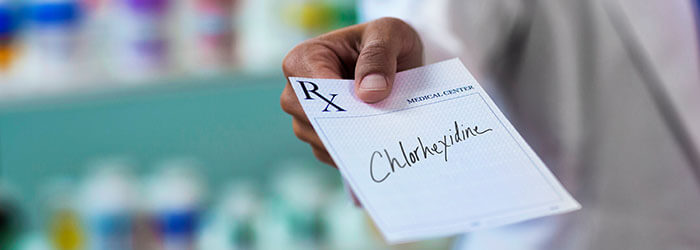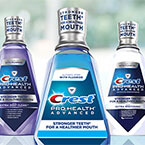Chlorhexidine Antibacterial Mouthwash: Pros and Cons

Summary
Table of Contents

This blog has been reviewed and approved by Dr Robert Lee, a dental professional of 35 years
LEARN MORE >What Is Chlorhexidine Mouthwash?
If you're being treated for gum disease or having certain dental procedures performed, your dental professional may prescribe a prescription rinse with antibacterial properties like chlorhexidine mouthwash. This rinse helps to control and kill the bacteria in your mouth that cause gum disease. In its composition, you will probably find chlorhexidine gluconate—which is the gluconate salt form of chlorhexidine.
Chlorhexidine is classified as a therapeutic agent with antimicrobial properties, in that it inactivates microorganisms with a broader spectrum compared to antibiotics and shows a faster kill rate than other similar agents. Depending on the concentration, the substance can have bacteriostatic (inhibits bacterial growth) and bactericidal (kills bacteria) effects. In vitro studies have shown that chlorhexidine can kill almost 100% of gram-positive and gram-negative bacteria within 30 seconds. So how does it work? Chlorhexidine gluconate is positively charged and reacts with a negatively charged bacterial cell. It penetrates that cell and leads to disruption of the cell membrane, resulting in death.
Chlorhexidine is commonly used in medicine, e.g., to wash the skin of a patient before an operation or to wash wounds. In addition, it is used in veterinary medicine for general dairy hygiene of cows. As for everyday use, you will find it in disinfectant lozenges (to treat mucositis, pharyngitis, laryngitis, and gingivitis), gels, and creams for disinfecting wounds, especially after burns and abrasions. On the other hand, chlorhexidine mouthwash is used to treat gum disease because of its anti-inflammatory effect. Because it inhibits plaque buildup, it is particularly recommended for gingivitis. Another advantage of this chlorhexidine mouthwash is that it remains in the mouth for about 8 hours and in saliva for up to 12 hours before bedtime.
On the positive side, chlorhexidine has powerful antibacterial properties, and can be especially helpful in maintaining a healthy mouth after a teeth deep-cleaning procedure such as tooth scaling and root planing. The effectiveness of this compound is also supported by many studies - in one of them, chlorhexidine was shown to be more effective in reducing S. mutans bacteria that accumulate around orthodontic brackets, in addition, it effectively eliminates streptococci, the bacteria that cause tooth decay.
Studies show that oral health is linked to overall health, in particular diabetes. Because diabetics are more prone to dry mouth, they have an increased risk of developing tooth decay and gum disease. The best mouthwash for diabetics is one that helps protect against dry mouth and plaque buildup that can lead to gingivitis.
Chlorhexidine Side Effects
Despite its beneficial effects on gum and oral health, chlorhexidine may be associated with side effects. Therefore, you should take extra care when using chlorhexidine products. Above all, avoid contact with your eyes. If the product gets into your eyes, rinse immediately with water and repeat the rinsing for about 15 minutes. If swallowed, nausea and stomach upset may occur.
At the beginning of use, you may notice decreased taste sensation, tingling of the tongue, and burning in the mouth. Keep a close eye on your mouth when using the product for gum disease. Chlorhexidine mouthwash can cause brown stains on teeth because chlorhexidine has been shown to bind to both hard and soft tissues.
More common side effects:
- Change in taste
- Discoloration of teeth, lips, tooth fillings and dentures or other appliances
- Mouth irritation
- Irritation of the tip of the tongue
Also bear in mind that chlorhexidine mouthwash is not intended for long-term use. Typically, one-month treatments are applied.
Contraindications and Precautions to Chlorhexidine Use
The U.S. Food and Drug Administration states that chlorhexidine-containing preparations are safe and effective. The only absolute contraindication to the use of chlorhexidine mouthwash is hypersensitivity to this medication or any of the ingredients contained in the product's composition. However, there are some precautions that you should take care of during your treatment.
If your dental professional prescribes a chlorhexidine wash for a short time while you're recovering from gum disease treatment, try not to drink too much coffee, tea, red wine, or consume any foods that may be likely to stain your teeth. Also, chlorhexidine mouthwashes or antibacterial rinses may not be the best choice if you have tooth crowns or caps made of composite or glass ionomer, as these materials may stain.
How to Use Chlorhexidine Mouthwash
Chlorhexidine gluconate rinse is a highly effective prescription medication for the treatment of gum disease. The dosage of the medication will vary from patient to patient, with 15 ml being considered the average dose. However, it is important to follow the instructions for use on the package and your healthcare provider’s recommendations.
The product is to be applied after brushing and flossing your teeth. First, thoroughly rinse the mouth off toothpaste and any debris. A standard practice is to rinse the mouth for about 30 seconds without diluting the preparation. Because chlorhexidine can have a bitter aftertaste, do not rinse your mouth immediately after using the liquid—this will increase the bitterness and the rinsing may weaken the effect of the medicine. It is recommended not to eat or drink for several hours after using the rinse.
History of Chlorhexidine Mouthwash
The history of mouthwash might goes as far back as ancient times. However, as an effective topical antiseptic, chlorhexidine mouthwash first came onto the scene in 1954. But it wasn’t until 1976 that researchers discovered its ability to reduce the development of plaque, and so the oral rinse soon became a popular prescription mouthwash.
Antibacterial Mouthwash Does Not Replace Brushing and Flossing
In general, it's not necessary to make chlorhexidine mouthwash a long-term part of your oral care routine, and even the best prescribed mouthwash does not replace tooth brushing and flossing. Once your gum disease is under control, following a regular routine of good dental hygiene that includes twice-daily tooth brushing, daily flossing, and regular visits to your dental professional should help to prevent further problems with gum disease.
Only from Oral-B, the #1 brand used by dentists worldwide*.
*BASED ON SURVEYS OF A REPRESENTATIVE WORLDWIDE SAMPLE OF DENTISTS CARRIED OUT FOR P&G REGULARLY
Sources
- https://www.ada.org/en/member-center/oral-health-topics/mouthrinse#:~:text=Antimicrobials%20in%20mouthwash%20formulations%20include, ketone%2C%20terpene%2C%20and%20ionone
- https://www.dentalplans.com/dental-information/dental-concerns/bacteria-in-your-mouth
- http://www.chm.bris.ac.uk/motm/chlorhexidine/chlorhexidineh.htm#:~:text=And%20what%20is%20the%20origin,skin%20flora%20by%20around%2090%25
Table of Contents
- What Is Chlorhexidine Mouthwash?
- Chlorhexidine Side Effects
- Contraindications and Precautions to Chlorhexidine Use
- How to Use Chlorhexidine Mouthwash
- History of Chlorhexidine Mouthwash
- Antibacterial Mouthwash Does Not Replace Brushing and Flossing
-
- Sources
- Related Articles

This blog has been reviewed and approved by Dr Robert Lee, a dental professional of 35 years
LEARN MORE >
Sign Up
for expert advice and exclusive offers

Sign Up
for expert advice and exclusive offers






